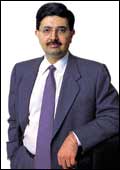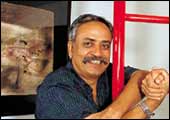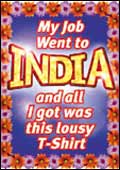|
 Bull
Charge On Dalal Street Bull
Charge On Dalal Street
Fuelled by foreign money, Indian markets had
a dream run.
The Indian stockmarkets
had a dream run in 2003. The benchmark Sensex spurted from 3,377
last year to 5,699 (on December 26), a whopping gain of 2,322 points.
Since the inception of Sensex in 1979, this is the largest gain
in any calendar year. The other indices too reflect the magnitude
of the rally. The Nifty touched its all-time peak on December 26.
The huge quantities of funds from overseas
have provided the much-needed trigger. Till December 24, the FIIs
had pumped a net investment of $7.43 billion (Rs 34,432 crore) into
the Indian market. This is the biggest net FII inflow into the country
since the foreign tribe was allowed into India in 1993, and also
more than double the previous high of $3.05 billion hit in 1996.
The weakening US dollar has helped to wean away some investments
from the US. For example, the net foreign investments in US assets
dropped from $62 billion in August to $16 billion in November.
-Narendra Nathan
Let The Games Begin
All's well that ends well in the Great Indian
Telecom saga. Or is it?
 |
 |
 |
 |
| Team telecom: (L to R) Mukesh
Ambani, Rajeev Chandrasekhar, Sunil Mittal, and Asim Ghosh |
The grand finale
of the long-festering slugfest between Reliance Infocomm in one
corner and pretty much all the other mobility players in the other
corner over the Ambanis' "tainted" entry into the wireless
space came to a rather abrupt end in October when the Telecom Regulatory
Authority of India (TRAI) recommended the unification of separate
categories of telecom licences. While these recommendations are
not binding on the government, it chose to go with them. Not in
a long time has the government moved so fast-within just four days
it accepted the TRAI recommendations and for good measure the Cabinet
also nodded its approval.
The clear winner was Reliance Infocomm which,
for a payment of Rs 1,542 crore, got the right to offer unfettered
mobility across the country. On Christmas eve, the government provided
additional relief to the older mobile operators by lowering their
licence fee. It also agreed to their demand to hike the foreign
investment limit in telecom companies to 74 per cent. As a result,
the court cases stand withdrawn and the associations representing
different lobbies are planning to come together as one.
In a sense, all companies are gainers. The
biggest gainer though is the customer.
-Vandana Gombar
 |
 |
 |
| Looking up: (L to R) Shashi
Ruia, B. Muthuraman and Sajjan Jindal |
Back From Hell
Steel is once again sexy, and might get even
sexier.
A couple of years
ago, almost every Indian wannabe steel baron-The Ruias, Mittals,
Jindals, et al-appeared down and out for the count. Steel prices
had collapsed just when their huge capacities had come on stream,
and they were on the verge of collapsing under the weight of chunky
interest charges and bloating losses. Then towards the end of 2002,
and right through 2003, steel prices maintained a northward trend.
Also coming to the aid of the steel companies was a more liberal
interest rate structure and the willingness on the part of the institutions
to restructure loans.
The buoyant demand conditions are likely to
be sustained in the current year too. That's because the global
steel sector is slowly, but surely, ironing out its overcapacity
issues, and the current oversupply situation is expected to turn
into a deficit by 2005.
-Narendra Nathan
 |
| Uday Kotak: At long last |
You Can Bank On Kotak
He finally gets his licence-and dollops of respect.
Uday Kotak and
2,500-odd employees of Kotak Mahindra Group won't forget 2003 in
a hurry. After many anxious years, Kotak Mahindra was finally granted
a banking licence, making it the first non-banking financial services
company allowed by the RBI to set up a bank. On the face of it Kotak
Mahindra, the 20-year-old financial services brand had it all: Retail
assets, a customer base, a branch network, an established brand
equity, the very things other new private sector banks were so aggressively
chasing. The banking licence, however, gives Kotak something he's
been yearning for a long time: Respect.
Now that they've got all that, Kotak and his
A-team led by the likes of career banker and the bank's Executive
Director Dipak Gupta have charted out an innovative and non-traditional
business model. As somebody once said, the good things in life take
time.
-Abir Pal
| BRAND BHARAT |
| COMPANY |
PRODUCT |
| Moser Baer |
CD-ROMs |
| Tata Steel |
Flat and long products |
| Nalco |
Aluminium |
| Arvind |
Textiles |
| Bharat Forge |
Forgings and castings |
| Bajaj Auto |
Two-wheelers |
Made In India, And Proud
Of It
It isn't the end of manufacturing. It will never
be.
Towards the late
nineties, manufacturing suddenly became unfashionable, and asset
creation was considered passé, as "new" economy
businesses with suspect revenue models and illogical valuations
ruled the roost. It's a bit different now. In 2003, India emerged
as the hottest manufacturing centre in the world for cars, two-wheelers,
tractors, auto components, steel and aluminium, textiles, petrochemicals,
CD-ROMs, and what not. Delhi-based Moser Baer is one of the top
three manufacturers of CDRs in the world. Tata Steel and Nalco are
the lowest cost manufacturers of steel and aluminium, respectively,
in the world. In textiles, Arvind Mills, Welspun, Trident, and Mahavir
Spinning Mills have made a strong comeback. Pune-based auto parts
company Bharat Forge is one of the leading suppliers to auto giants
like Ford, General Motors, and Toyota, who themselves have to cut
costs to stay ahead in an increasingly competitive market by obtaining
cheaper parts from countries like India. This year, Bajaj Auto will
ship 1.5 lakh vehicles to South East Asia, Africa and Latin America,
which will take its exports from Rs 353 crore to Rs 560 crore. Long
live Indian manufacturing!
-Sahad P.V.
 |
| Brian Tempest: To head Ranbaxy's global
binge |
Global Charge
India Inc. takes its first steps in its quest
to achieve global dominance.
For corporate India,
most of the action in 2003 was outside the country. Every month,
on an average, three Indian companies ventured overseas, and in
all corporate India has committed a little over $600 million in
international acquisitions. In October 2003, Reliance Infocomm made
a pitch for international undersea telecom operator FLAG Telecom
Group for $207 million (Rs 950 crore). It still awaits shareholder
approval, but once completed, it would be the second largest cross-border
deal. Ranbaxy Laboratories' acquisition of French generics company
RPG Aventis (for roughly Rs 385 crore) is the largest ever overseas
acquisition by an Indian pharma company. Wockhardt is another leading
pharma company, which lapped up CP Pharmaceuticals of the UK in
July 2003 for £10.85 million (Rs 85 crore).
-Sahad P.V.
 |
| Piyush Pandey: Reflections of the feel
good factor |
Creating Growth
The ad industry records double-digit growth
after three years.
Six lions including
three golds at Cannes; a five-day jamboree at Jaipur with Ad Asia
coming back to the country after 22 years; and o&m's Piyush
Pandey selected as the President for two juries at Cannes 2004...it's
been an eventful year for Indian advertising. To cap a perfect year,
money too began pouring into the industry's coffers. Says Subhabrata
Majumder, media analyst at brokerage firm Motilal Oswal: "2003
has seen a growth of 12.5 per cent in total billings and over the
next three years the industry should grow at 15 per cent annually."
The cricket World Cup did its bit, with some
Rs 800 crore estimated to have been spent on advertising. The Reliance
Infocomm account is estimated to be around Rs 200 crore and the
government's India Shining campaign obviously added to the feel
good factor. Says Pandey, who succeeded Ranjan Kapur as Executive
Chairman of O&M: "Though we may not have seen great work
this year, clients are looking for creativity and are more demanding.''
High time they did!
-Dipayan Baishya
News Breaks Out
Media finds its own place in the sun.
The deal sizes
are smaller, the valuation less fancy, but the excitement levels
amongst investment bankers has perhaps never been as high. Globally,
media has been a favourite hunting ground for investment bankers
and deal-makers, but hardly so in India. However, 2003 saw an unprecedented
number of media deals and for a change most are not in the entertainment
segment. NDTV, separating itself from the Star TV platform, launched
two channels, also secured a valuation of $121 million and sold
9.49 per cent to Standard Chartered Private Equity for $11.5 million
(Rs 53 crore). Forced by regulations to bring down its stake to
26 per cent in Star News, Rupert Murdoch came to India scouting
for partners.
After an aborted attempt to sell the stake
to a clutch of investors, the Ananda Bazaar Patrika Group succeeded
in picking up 74 per cent in Star News for Rs 74 crore. Financial
Times, part of the Pearson Group, picked up a 13.85 per cent stake
in Business Standard for Rs 14.1 crore. Hindustan Times raised Rs
125 crore by selling 20 per cent in HT-Media, a 100 per cent subsidiary,
to Australian financial services company AMP Group Holdings.
CNBC Asia diluted its 49 per cent stake in
CNBC India to 10 per cent in favour of its programming partner TV18
and changed its name to CNBC-TV18. Last, but not least, TV Today
Network approached the market with a 25 per cent public offer (the
issue was oversubscribed 36 times). Expect the action to continue
in 2004.
-Dipayan Baishya
 Cheap
And Best! Cheap
And Best!
Many Americans and Britishers lost their jobs
to Indians.
A glance at the
t-shirt in this picture would tell you what this story is all about.
Whilst it jobs have been moving to India for a while now, in 2003,
thousands of skilled and semi-skilled employees in the US, the UK
and parts of Europe lost their jobs to Indians, where their counterparts
cheerfully did what they used to do at a much lower cost. Protests
ruled the roost in the US, with no less than five American states
proposing bills to stop outsourcing of jobs to India. Not surprisingly,
the American reaction centred largely around legislation, what with
1,000 employees of Sun Microsystems resorting to a lawsuit against
the firm on charges of racial discrimination (in favour of Indians!)
in March. The British reaction, on the other hand, was to take to
the streets in an organised protest. An announcement by British
Telecom of their decision to move 2,000-odd call centre jobs to
India resulted in staged demonstrations outside 34 UK call centres
by the Communications Workers Union, a trade union body, early this
year. The backlash could well intensify, if you consider that 3.3
million US services industry jobs and $136 billion in wages are
expected to move offshore within the next 15 years, according to
tech research firm Forrester.
-Priya Srinivasan
Great Future For Options
The derivatives segment outstrips the cash market.
The derivatives
(futures and options) market in India came of age in 2003. It was
in June 2000, that the first tentative steps were taken with index
futures, which recorded a modest monthly turnover of Rs 35 crore
on the NSE. By June 2001, the NSE was offering index options, and
the total turnover crept up to Rs 785 crore. The growth since then
has been mind-boggling, and as of November, the derivatives segment
was doing a monthly turnover of Rs 1,92,171 crore on the NSE-well
above the turnover in the cash market. "The speed of growth
this year is really surprising," gushes Satish Menon, Chief
Operating Officer at Geojit Securities. "With investors learning
more about the nitty-gritty of options, the fear about it has gone,"
he adds.
Yet, it isn't as if the retail investor is
active in derivatives. Hardly. Thanks to SEBI putting a minimum
Rs 2 lakh limit for derivatives trading, the value of which has
since gone up to Rs 10 lakh at several counters as the market moved
up, it is largely the speculators who contributed to most of the
turnover. Perhaps 2004 will see more retail investors using derivatives.
-Narendra Nathan
|
